Birth of a New Genre
In 1993, designer Mark Hermann and Avalon Hill released We the People, the first card-driven historical wargame. Since then, the genre has become quite popular and other designers have extended on Mark’s original concepts. This evolutionary – and at times revolutionary – process has added to the richness of the wargaming experience.
Prior to the release of We the People, most wargames were of the hex and counter variety. That is, a hexagonal grid was superimposed on the map which regulated movement, and the playing pieces were cardboard counters that represented specific unit types (infantry, cavalry, artillery, armor, etc.). Mark Hermann changed all of that. Instead of a hexagonal grid, the We the People board consists of spaces connected by lines to other spaces, what is now known as a point-to-point system. While cardboard counters were still used, they represent generic strength points rather than specific units. The game also introduced stand-up counters representing specific Generals, such as Hannibal and Scipio Africanus.
But perhaps the biggest innovation We the People introduced were the cards. The game includes two types of cards: Battle Cards and Strategy Cards. Instead of rolling dice on a combat results table, the players alternate playing Battle Cards. The number of cards each player receives in battle is determined by the number of strength points they have, the General’s battle rating, and other factors. The attacking player plays a card first and the defender must play a matching card or lose the battle. The defender can attempt to become the attacker by attempting a counterattack. This is accomplished by rolling a die that is less than or equal to their General’s battle rating. This process continues until one of the players is unable to match the opponent’s Battle Card.

The Strategy Cards come in two types: Events and Operations. Event cards describe a specific action the player can take if they play that card. Some events can only be played if specific conditions are met. Operations cards can be used in one of three ways. First, they can be used to activate/move any Leader (and accompanying combat units) whose strategy rating is less than or equal to the number printed in the upper left-hand corner of the Operations card. Second, it can be used to place that number of political control markers on empty spaces. Finally, it can be used to bring reinforcements into play.
Variations on a Theme
The We the People system became the blueprint upon which a whole series of wargames were spawned. These games, some of which were also designed by Mark Hermann, used cards in a similar way on a point-to-point movement map. But each new game included new features. For example, Hannibal: Rome vs Carthage, released in 1996, used both Strategy and Battle Cards. But, unlike its predecessor, the Strategy Cards in Hannibal are not divided into two types. Instead they are dual use; they can be used for the event described on the card or as an operations card. However, some events can only be used by the Roman player (those with the black circle), others only by the Carthaginian player (with the white circle), and still others by either side (those with a split circle). In addition, cards with the trireme symbol in the upper right-hand corner can be used to perform naval movement.

Next came Successors in 1997. Depicting the struggle for Alexander the Great’s empire after his death, the Tyche (Greek for fortune or luck) cards come in four varieties. Event cards can be used for the event printed on the card or to place garrisons on the map up to the number shown on the card. Bonus cards can be used for both the event and garrison points. Surprise cards can be played at any time, even during your opponent’s turn. Lastly, the General cards allow you to bring a new leader and additional troops into the game as reinforcements. Instead of battle cards, combat is determined by each side totaling their battle strength and rolling a die. The die roll can be influenced by the commanding General’s battle rating. Cross indexing the army’s battle strength with the modified die roll determines the battle score. The side with the lower battle score is the loser.
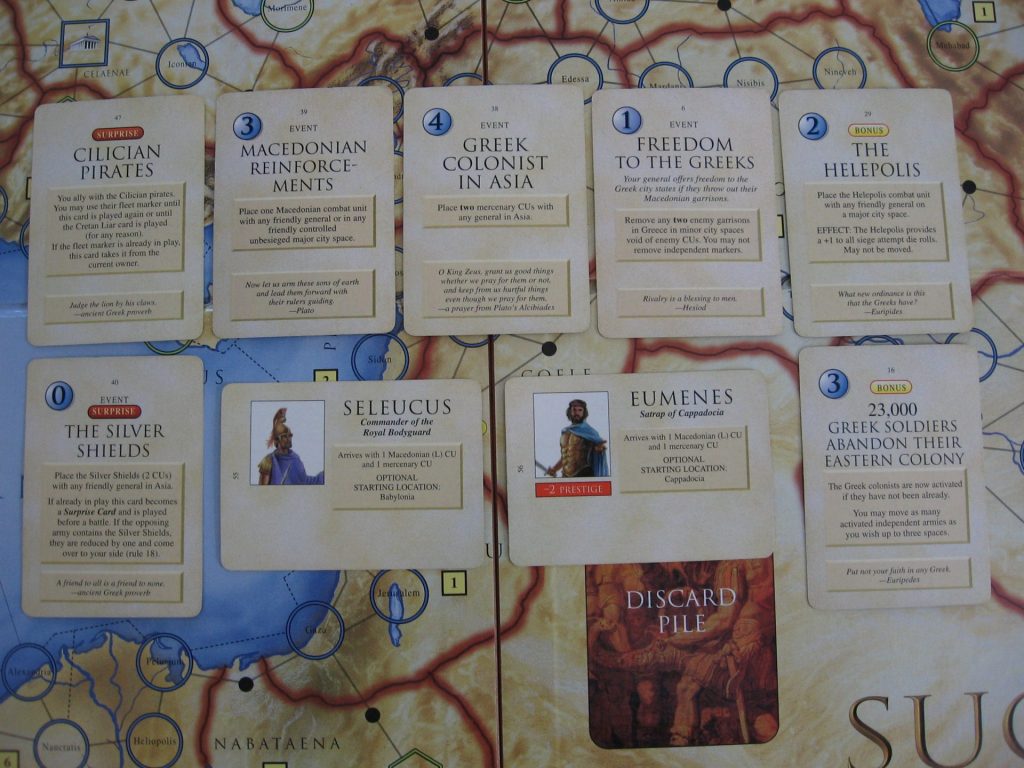
The Napoleonic Wars, released in 2002, continued the trend of increased differentiation in card types. Although the cards can be used either for the event or for the Command Point value printed on them, several new card types were introduced. Response cards work much like the Surprise cards in Successors in that they can be played at any time. Battle cards can be used in combat to influence the outcome of a battle. Foreign War cards trigger wars in other parts of the world and require one of the players to redeploy troops. Some cards cannot be played in 1805 (the first year of the game), others must be discarded if used for their event, and yet others have continuing game effects.
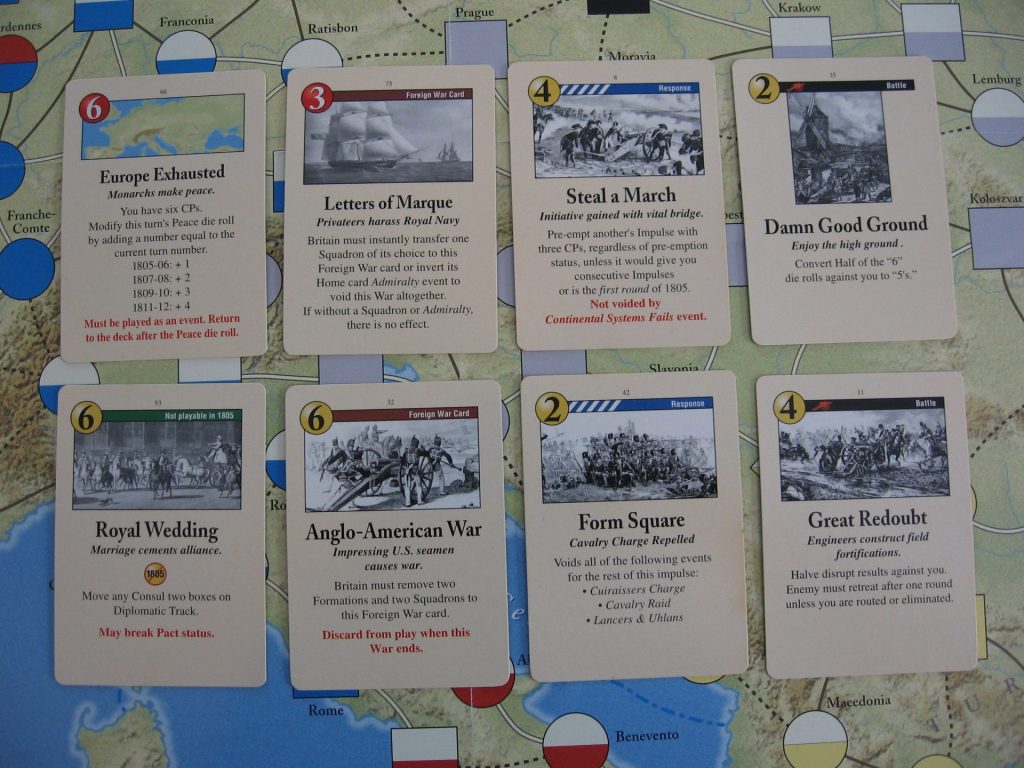
Many other card-driven games were published over the years (Sword of Rome, Paths of Glory, The Halls of Montezuma, etc.). They all adhered to the same general design pioneered by We the People: a point-to-point map with multi-use cards and different card types. But this was soon to change.
Commands & Colors
The arrival of Memoir ‘44 in 2004, followed by other games in the Commands & Colors system, heralded a new type of card-driven mechanic. Rather than cards that can be used for multiple purposes, the Commands & Colors system uses cards that have only a single purpose: to activate certain units on the board.
Commands & Colors game boards are divided into three sectors: left, right, and center. A hexagonal grid is superimposed on the board to regulate movement. The playing pieces are wooden blocks or plastic figurines that represent different types of units, with each unit composed of one to four blocks/figurines. As units take hits, blocks are removed until they are eliminated. In some respects, the cards resemble the Battle Cards first seen in We the People. The cards dictate which sector of the board is being ordered to move and/or attack. The cards may also indicate what type of units (heavy, medium, or light troops) can be activated. This results in a very fluid, fast-paced game that is not prone to the “analysis paralysis” often seen in other card-driven games.
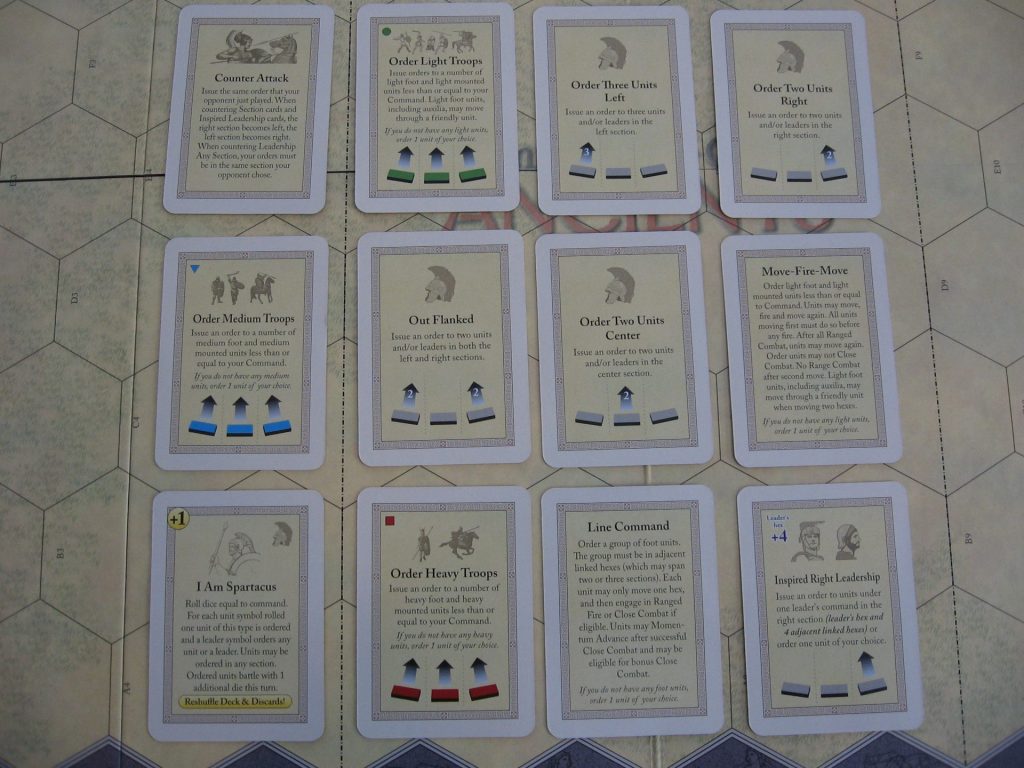
The Commands & Colors system is also quite versatile. Games span ancient Greco-Roman warfare, Medieval combat, the American Revolution, the Napoleonic wars, World War II and even Samurai and space-based combat. Each series adds new unit types with unique abilities, thus keeping the game experience fresh. Plus, they all come with numerous scenarios. As such, we will likely see new games in this system for some time to come.
No Retreat! Card-Driven or Card-Assisted?
In 2008, Victory Point Games released No Retreat! The Russian Front, 1941-1945 and in the process introduced a mash-up of classic hex and counter wargames combined with cards. The system was designed by Carl Paradis and has since been taken over by GMT Games. The series now includes several titles covering various theatres of World War II Some will argue the No Retreat! series is not a card-driven game because the cards do not activate and move units. Rather they are used in other ways that supplement normal hex and counter game mechanics.
Called Event Cards, each has two halves. One half describes an event that can be used by one of the players while the other half describes a completely different event that can only be used by the other player. In addition, each card specifies when during the turn sequence (strategic phase, movement, combat, etc.) it can be played. The cards can also be discarded to bring in reinforcements and replacements, among other uses. While the cards do not directly activate units, players still must decide how to use the cards in their hand for the maximum effect. Some No Retreat! games include other types of cards, such as the Leader cards shown here.
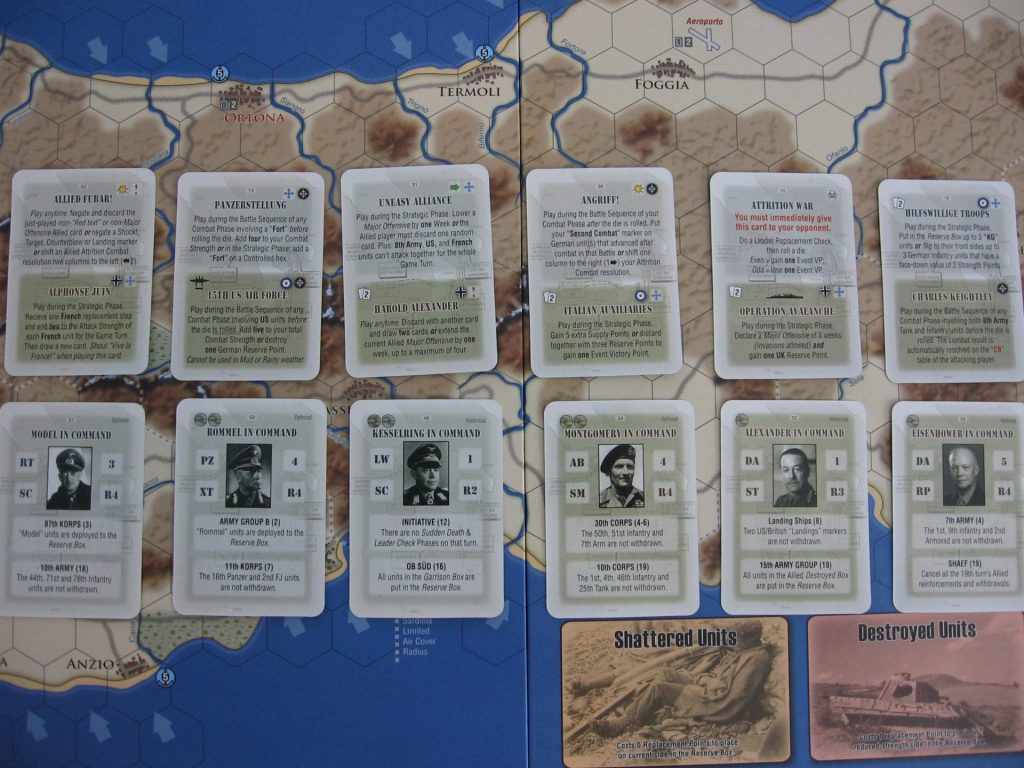
Card-Driven Solitaire Systems
Many solitaire game systems use a series of charts and tables to control the actions of the game’s Artificial Intelligence (AI). The player rolls a die or some dice and consults the appropriate table for the turn phase they are in to see what actions are taken. Designer John Butterfield introduced the use of cards to perform a similar function that eliminates all the die rolling.
The first of these, RAF The Battle of Britain 1940, was released in 2009 and allows you to play as either the RAF or the Luftwaffe when playing solo. To manage this, four different types of cards regulate the actions of the AI during different phases of the turn. The Target Cards reveal where the next air raid is headed and which RAF fighter sectors can respond depending on the amount of warning and intelligence condition. Strategy Cards dictate the size and composition of the raiding force. Event Cards describe events that occur while the raid is enroute and over the target as well as how much time has elapsed that day. The Day Cards are used once the day is over to determine how many days will elapse before the next raid and how many reinforcements each side receives.

John Butterfield’s D-Day series focuses on U.S. amphibious landings. It uses cards of a single type for all phases of the turn. However, each card details what action to take depending on the turn sequence phase in which it is drawn. The player consults the appropriate section of the card to determine its effect. For example, to determine the outcome of an amphibious landing, the player consults only the top section of the card under “Landing.”
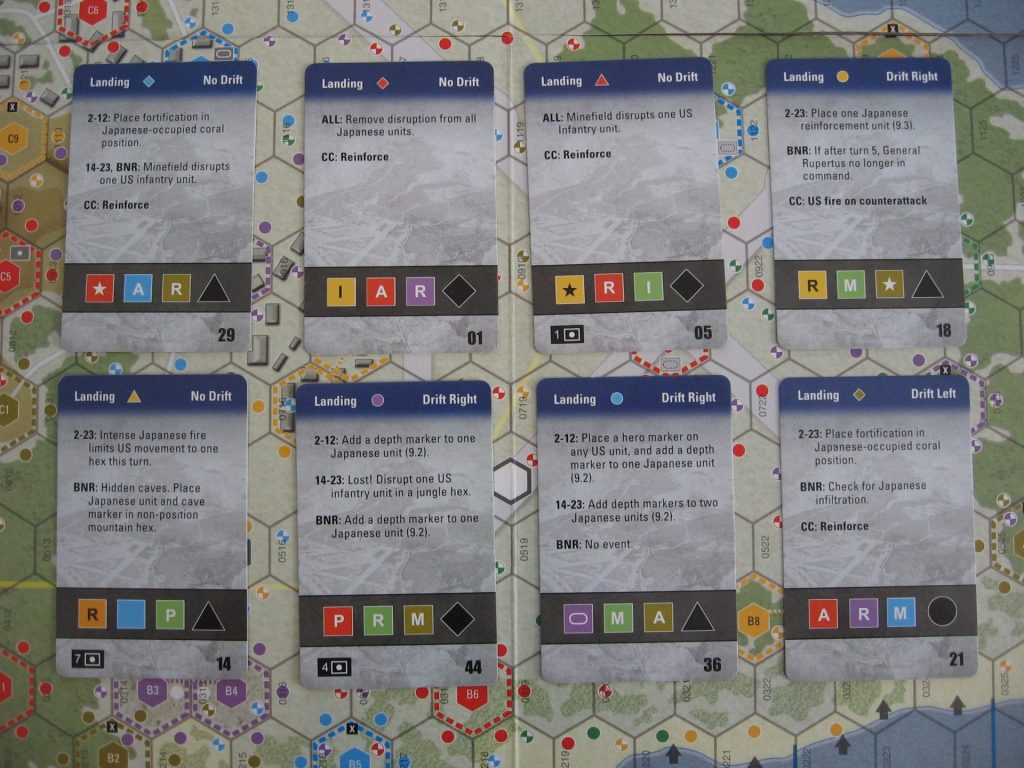
A unique innovation of this series is the use of common iconography on the cards, map and playing pieces. Japanese fields of fire are shown on the board by colored dots. These indicate which hexes a Japanese unit occupying a specific colored hex can fire into. The cards also contain colored symbols. When drawn in the AI’s fire phase, only units occupying hexes of those colors can fire. The cards also include a black shape symbol (circle, triangle or diamond). Only those U.S. units with the matching shape symbol can be fired upon. This adds to the fog of war as neither side can be certain which units will fire and which units will be susceptible to that fire.

The Enemy Action series, also designed by John Butterfield, allows you to play solo as either the Allies or the Germans and can also be played 2-player. Each side has their own Command Card deck that is used to activate formations, deploy reserves, check for combat tactics, etc. A deck of German Setup cards randomizes the initial placement of German and Allied formations when playing as the Allied player. When playing the German side, an Allied Action card deck is used to determine what actions Allied units activated by an Allied Command card that turn will perform.

Mr. Butterfield’s use of customized cards, in lieu of die rolls on charts and tables, makes for a faster playing game and allows the addition of “chrome” (wargamer speak for extra bells and whistles) without the need for specialized rules. It also continues the trend of increased card differentiation by packing more information on them for multiple purposes.
COIN Games
The first in the COIN (short for Counter Insurgency) series, Andean Abyss, was released in 2012 and introduced a new type of card-driven mechanic. The top of each card indicates the faction order. Eligible factions – those that did not execute either an Operation or Event during the previous turn – can execute either an Operation or play the Event on the card this turn. They can also choose to pass which preserves their eligibility status. Ineligible players can do nothing. Since there are four factions in each COIN game, the two eligible factions will be able to do something that turn while the two ineligible factions will not. A further subtlety is that the rules limit what the second eligible player can do depending on the action taken by the first eligible player. This simulates the ebb and flow of initiative between the various factions.
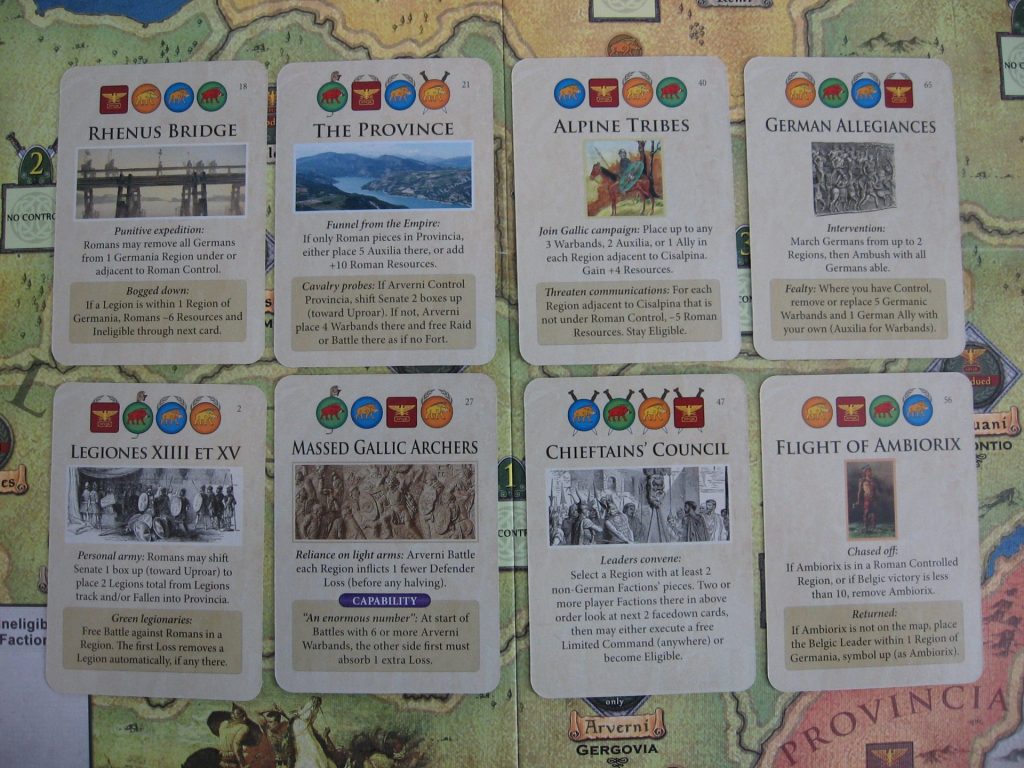
The COIN system has been used to model modern counter insurgency operations, such as in Afghanistan and the Vietnam War, as well as similar asymmetric warfare from history (e.g., the American Revolution and the Gallic revolt against Caesar). There are currently nine titles in the COIN series with three more on GMT Games’ P500 list that are in various stages of development. Given the long history of asymmetric warfare, there is a large supply of conflicts that could be given the COIN treatment.
A New Breed?
In 2019 Worthington Publishing released Devil Dogs: Belleau Wood 1918. It depicts the American advance into Belleau Wood which effectively ended Germany’s last offensive on the Western front and “solidified the reputation of the US Marine Corps as an elite fighting formation.” The game was designed by the father-and-son team of John Poniske and John Poniske Jr. and uses cards in a way that is both familiar and new.
Like Commands & Colors, the Devil Dogs map is divided into sectors – four versus the three in Commands & Colors. Both sides have a deck of Command cards. On their turn players choose a Command card to play in each sector, placing it face down on their board edge. Every card lists three different orders: an Active Order, a Reactive Order and a General Order. Active Orders tend to be more aggressive in terms of both movement and combat. As one might suspect, Reactive Orders are less aggressive and represent a side responding to what the acting player is doing. General Orders represent just that: all-purpose orders that cover what units would do in the absence of an Active Order from their commanding general.
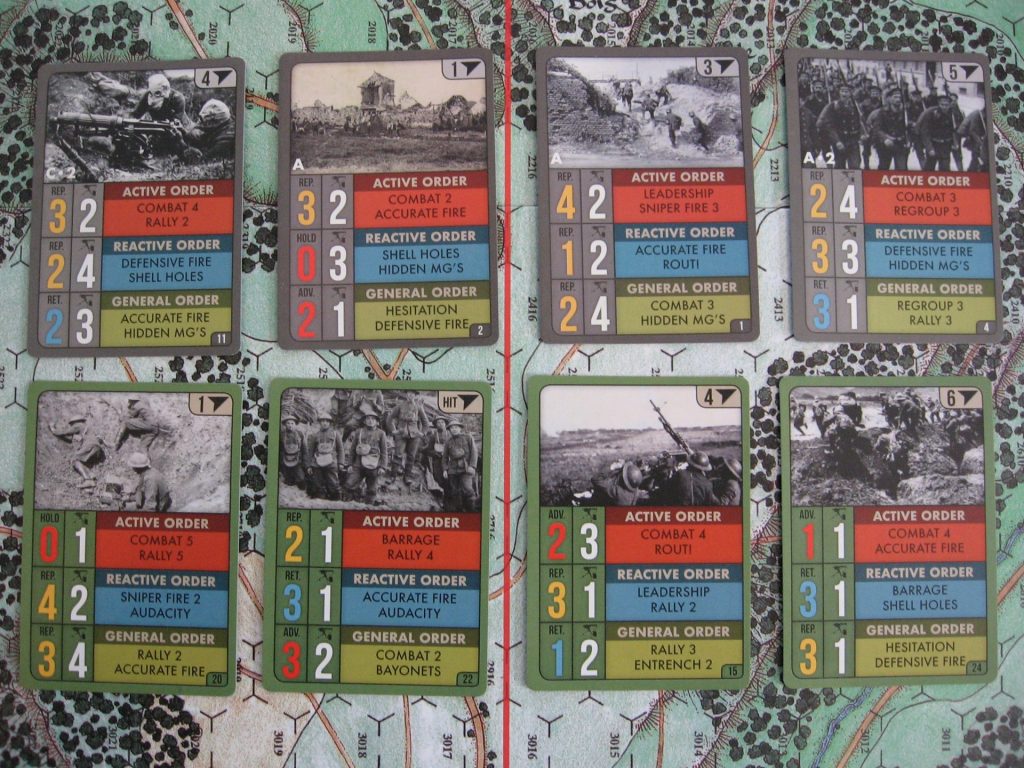
The players then determine who has initiative in each sector. This is accomplished by randomly drawing Initiative Chits from a cup. The number of Initiative Chits is influenced by the position of the Initiative Marker on the Initiative Track. In general, the stronger the initiative is on your side, the more chits you have available to put in the cup. Inflicting more casualties shifts the position of the Initiative Marker in your favor. The side with initiative in a sector is considered the Active player and the other is the Reactive player. If the initiative is tied (Stalemate) then both players are considered the Reactive player.
Each player then determines which of the three orders – Active, Reactive or General – they will use in each sector. The initiative player can choose to use either the Active or General Order on the card they played for that sector. If you are not the Active player, or in the case of a stalemate, you must choose either the Reactive or General Order. The side with the most sector initiatives has overall battlefield initiative and gets to choose which sector to activate first. In case of a tie, the scenario attacker has battlefield initiative. The players alternate activating sectors until all four sectors have been activated. The Reactive player acts first in each sector followed by the Active player. This gives the Active player the advantage since Reactive and General orders tend to be less aggressive than Active orders.
Here is a system unlike any other and the cards are at the heart of the system. What they simulate is the commanding general’s intent regarding what they want their units to do in each sector. However, the fog of war element introduced by initiative uncertainty means that the commanding general’s plan can be upset. You may have planned to make an aggressive thrust on the right flank, but because you lost the initiative in that sector, you are now forced to react to the enemy’s attack. It is a very clever and elegant solution that rewards both good planning and luck.
Will Devil Dogs introduce a new series of games using this same card-driven mechanic? Or will other designers extend on the Poniskes’ concept to create other mechanics? Only time will tell.
Summary
That concludes our journey through time. It is not possible to mention every card-driven game and mechanic. There are many great ones out there (Empire of the Sun, and Combat d to name just a few). Regardless, I hope this history gives you some idea how card-driven mechanics have evolved and how it has impacted game play. The use of custom cards altered the face of wargaming and created a whole new genre. It will be interesting to see what new innovations the future has in store.


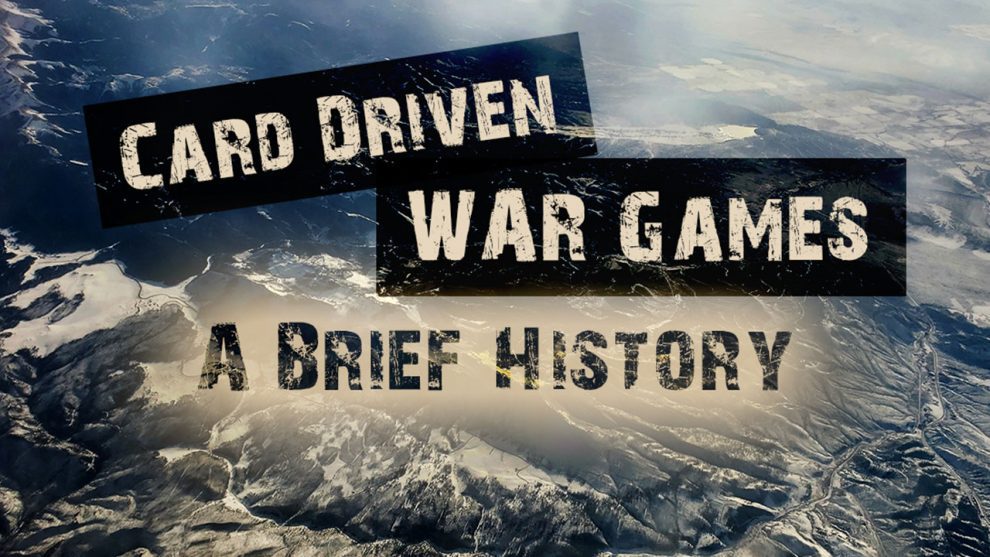








I’m surprised to see an article about card-driven wargames that makes no reference to the excellent, and quite ahead of its time, Up Front designed by Courtney Allen and published by Avalon Hill in the late 1980’s.
Edit: Sorry, that should be early 1980’s. A quick check on Boardgamegeek shows it was first published in 1983. I fondly remember playing it, with both the desert war and banzai expansions, by the mid-to-late ‘80’s.
John, as I said near the end of the article, I couldn’t mention every card-driven game. I’m certainly aware of Up Front, but I’ve never played it. Whereas all the other games I mentioned I have played. Nothing against Up Front, it’s just that I purchased Squad Leader way back when, including the first three expansions, so I decided to stick with that system.